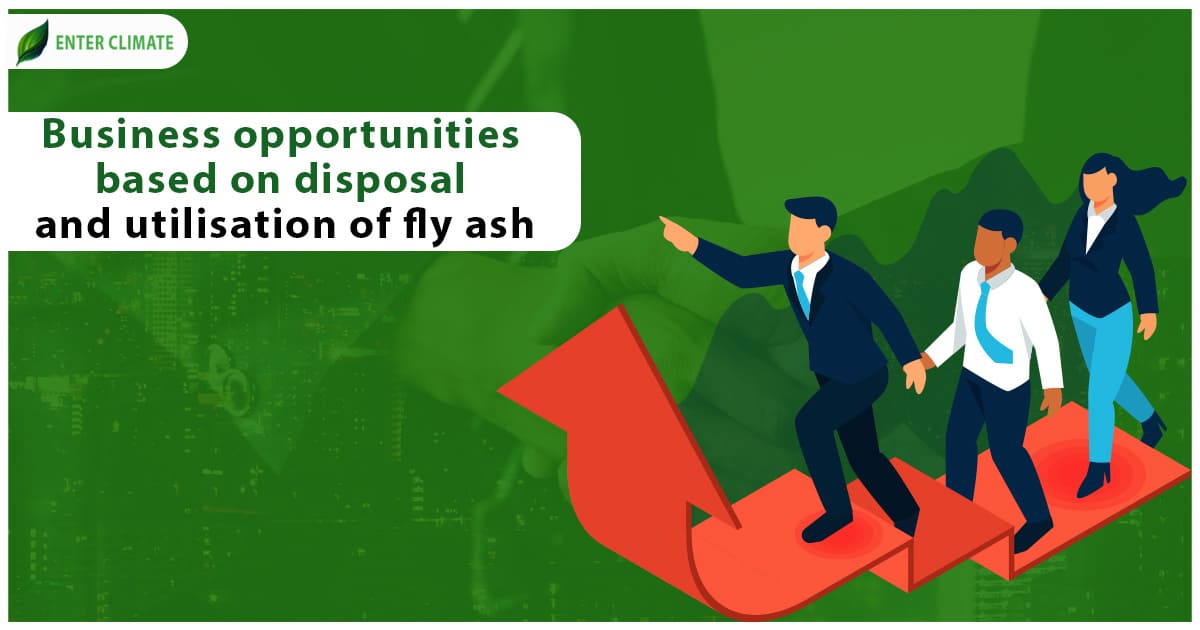Business opportunities based on disposal and utilisation of fly ash
 26 May, 2023
26 May, 2023 
Fly ash is a resource element that has demonstrated its value over time despite formerly being viewed as waste and a source of air and water pollution. Fly ash consists of oxides of aluminium, silicon iron and calcium. It also contains small amounts of sodium, magnesium, potassium, titanium, and sulphur. But the issue is that India generates an enormous amount of fly ash. According to the Central Electricity Authority, India has over 200 coal power plants that generated 232.56 million tonnes of fly ash in 2020-2021, much more than could be utilised. Although 93% of it stood utilised, millions of tonnes that have accumulated over the years lie unused. As per some studies, over half of India’s power plants fail to utilise their fly ash fully and fall behind previous government targets. Through this article, we will understand the guidelines on the disposal and utilisation of fly ash as well as the business opportunity for units that can utilise the legacy fly ash.
As per the Fly Ash Utilisation Rule on disposal and utilisation of fly ash, it is now mandatory for Thermal Power Plants to ensure 100% utilisation of fly ash within 3-5 years. In addition, the CPCB also released guidelines for using fly ash for the reclamation of low-lying areas.
Environmental impact of fly ash
Fly ash is the residue from combustion of coal, which is hazardous if disposed of improperly. One of the biggest sources of pollution influencing the general aesthetics of the environment in terms of land usage, health risks, and air, soil, and water, in particular, is identified as coal-based thermal power plants. This leads to environmental problems. Fly ash control and disposal in coal-fired thermal power stations is a significant issue. The composition of the fly ash emissions from various coal combustion units varies greatly. Some fly ash from coal-fired power plants escapes into the atmosphere. Both dry and wet disposal methods are available for fly ash. Studies demonstrate that wet disposal does not prevent metals that can still leach into the ground. Thus, the disposal and utilisation of fly ash is a cause of concern for future. A comprehensive new Ash Utilisation Policy for ash utilisation has been announced that has a system of environmental compensation based on the polluter-pays principle. Thermal power and lignite plants are not able to use or dispose 100 per cent of the fly ash they generate in an “eco-friendly” way will face penalties as per the orders of the NGT.
Rule on disposal and utilisation of fly ash
- The ash generation in coal and lignite-based thermal power plants in various forms, such as bottom ash, dry ash, pond ash and mound ash, must be managed so that it does not affect the environment.
- The utilisation of ash for reclamation of low-lying areas and abandoned quarries is recognised as an alternate option, and therefore, MoEF&CC[1] has issued a notification to address the utilisation of ash for various purposes, including these two options.
- As per the new rules, the only ways the fly ash can be disposed of or utilised include the construction of roads, manufacturing of bricks, tiles, and cement and export to other countries.
The existing rules on disposal and utilisation of fly ash also allow for the filling of empty mines, filling of low-lying areas and in agriculture in a controlled manner based (after soil testing). The changes in the Ash utilisation rules can be understood from the table below,
| Year | Laws on Ash Utilisation |
| 1999 | Predetermined goals for using fly ash produced by thermal plants. |
| 2003 | Existing law required building companies to gradually transition to using only fly ash over the course of five years, through August 2007. |
| 2009 | revised and lengthened the implementation schedules for reaching 100% utilisation gradually by 2014 |
| 2014 | mandated that coal with an ash concentration of no more than 34% be used in all thermal plants more than 500 kilometres away from a coal mine. |
| 2016 | mandated that coal with an ash concentration of no more than 34% be used in all thermal plants more than 500 kilometres away from a coal mine. |
| 2019 | Under the environmental clearance (EC) requirements for thermal power stations, certain fly ash uses, such as mine filling, reclamation of low-lying areas, and as a soil conditioner in agriculture, was forbidden. Such EC conditions are reversed by the 2019 amendment to improve utilisation. |
| 2020 | removed the 34% ash content cap that was required by the 2014 notification. |
| 2021 | Mandatory three-year cycle requiring the use of all ash for “eco-friendly purposes.” |
MoEF Guidelines for Disposal and Utilisation of fly ash for Reclamation of Low-Lying Areas
MoEFCC released an Office Memorandum (OM) allowing the use of fly ash in low-lying area reclamation, filling abandoned mining voids, and as a soil conditioner in agriculture. The Expert Appraisal Committee (EAC) has been imposing conditions on thermal power plants (TPPs) since 2012 that prohibited the use of ash in this way (or only allowed backfilling mines with lining and prior approval from SPCBs. All current environmental permissions related to the disposal and utilisation of fly ash have been updated by this OM, which also changed the restrictions to permit the use of fly ash in low-lying areas, agriculture, and mining voids. When dumping fly ash in low-lying regions, new instructions from the Central Pollution Control Board (CPCB) have been released in addition to the OM. Before and after the ‘reclamation’ of low-lying areas using ash, power plant and land owners must adhere to a number of requirements outlined in the OM and the Guidelines.
- Consent from landowner
- Permission from Regulatory authority
- Prevention of pollution
- Soil Cover on the top of ash fill
Regulatory Procedure for Processing the Request for Reclamation of Low Lying Areas / Abandoned Quarries
The Water Act and the Air Water Act will govern the reclamation of Low-Lying Areas and abandoned quarries. The guidelines’ requirements align with those of the Fly Ash Notification, 1999, as amended, which should be a special condition mentioned in consent orders issued under the Water Act of 1974 and the Air Act of 1981. Following that, any rule violations will be prosecuted under these Acts, and appropriate action will be taken under Consent Administration by the Board. The necessary approvals must be obtained from the relevant organisations, such as the DGMS, SPCB, IBM, MoC, etc.
How can one transform the disposal and utilisation of fly ash into a profitable Business?
- There is a lack of units that can use the fly ash in an eco-friendly manner. Fly ash type is categorised based on its chemical composition, i.e. Class C (with high-calcium content) or Class F ash (low-calcium fly ashes with carbon contents less than 5%).
- These categories of fly ash can be largely used as a mineral admixture in concrete. Recent studies have demonstrated several uses for coal fly ash as a raw material, including as a soil improvement agent in agriculture, in brick construction, in the construction of highway embankments, in the production of zeolites, in the formation of mesoporous materials, in the synthesis of geopolymers, for use as catalysts and catalyst supports, and as an adsorbent for gases.
Conclusion
The disposal and utilisation of fly ash in the construction industry is not new. Adding fly ash to concrete gives construction projects economic, ecological and technical benefits. Manufacturing bricks, tiles, cement, building roads, and exporting to other nations are among the “only” uses for fly ash. But it is a growing technology in improving the construction quality as well as the environmental quality. Any of the above businesses can be set up in areas with thermal power plants as it will guarantee a regular and cheap supply of raw materials. However, adhering to environmental regulations is crucial such units are classified under the red category and, therefore, will need pollution NOC along with other necessary licences and permits. Seeking assistance from licencing and environmental experts can simplify the business setup.
Read our Article: New Business Opportunities Under The National Green Hydrogen Mission Of India













